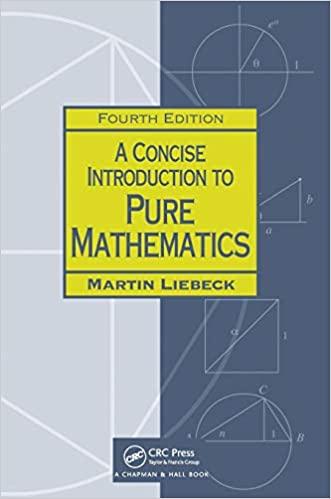Here is an exercise, not for the faint-hearted, leading you through the rigorous construction of the real
Question:
Here is an exercise, not for the faint-hearted, leading you through the rigorous construction of the real numbers from the rationals \(\mathbb{Q}\) and proving the Completeness Axiom.
Call a subset \(S\) of \(\mathbb{Q}\) a Dedekind cut if \(S eq \emptyset, \mathbb{Q}\) and \(S\) satisfies the following two conditions:
(i) for any \(s \in S, S\) contains all the rationals less than \(s\)
(ii) \(S\) has no maximum (i.e., there is no element of \(S\) which is greater than all other members of \(S\) ).
(For example, \(S=\left\{x \in \mathbb{Q}: x<\frac{1}{2}\right\}\) is a Dedekind cut, but \(\left\{x \in \mathbb{Q}: x \leq \frac{1}{2}\right\}\) is not.)
Define \(\mathbb{R}\) to be the set of all Dedekind cuts. We need to define addition, multiplication and ordering on \(\mathbb{R}\) and show that it has all the basic properties such as Rules 2.1 and the Completeness Axiom.
Strangely, perhaps, it's easier to get the Completeness Axiom than the other things, so let's do this first. Define an ordering on \(\mathbb{R}\) by simply saying that if \(S, T\) are Dedekind cuts, then \(S Now for addition, multiplication and so on. First identify \(\mathbb{Q}\) with a subset of \(\mathbb{R}\) by taking \(q \in \mathbb{Q}\) to the Dedekind cut \(S_{q}=\{x \in \mathbb{Q}: x For two Dedekind cuts \(S, T\), define their sum to be \(S+T=\{s+t\) : \(s \in S, t \in T\}\). Show that this addition agrees with the usual addition on \(\mathbb{Q} \subset \mathbb{R}\). Similarly define multiplication on \(\mathbb{R}\) and division on \(\mathbb{R}-\{0\}\) and show that they agree with their usual definitions on \(\mathbb{Q} \subset \mathbb{R}\). [This needs to be done rather carefully - for example, the obvious definition of multiplication \(S T=\{s t: s \in S, t \in T\}\) does not work at all. Here's a hint to get you started: for \(S, T>0\) (where 0 is identified with \(S_{0}\) as above), define \[ \left.S T=\mathbb{Q}_{\leq 0} \cup\{s t: s \in S, t \in T \text { with } s>0, t>0\} .\right] \] Show finally that these definitions of,\(+ \times\) satisfy the Rules 2.1 .
Step by Step Answer:






